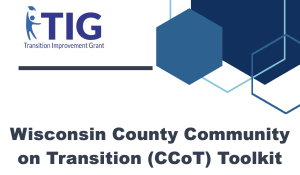Please note TIG will be updating the Self-Advocacy Suite.
Clovis Grove Elementary School
Implementing a co-teaching model for universal-level instruction
The staff at Clovis Grove Elementary School in Menasha are determined to maximize the learning time in the school day for each student. One part of achieving this important goal is increasing instructional opportunities through reducing office discipline referrals, and specifically, decreasing the number of students who are repeatedly referred to the office. Clovis Grove took a hard look at the range of supports they offered and identified three areas for systemic improvement.
First, the school worked out a co-teaching model. “We want all of our children to be in our classrooms as much as possible… and that’s supported through co-teaching,” Principal Tammy Richter said. This practice allows students with Individualized Education Programs (IEPs) and English Learners to be included in all universal-level instruction. Coaches regularly check in with teachers and provide support to help them build their capacity to provide inclusive instruction. Additionally, the school ensures that every classroom has community building time so every child feels included and every child has a voice in the classroom, Richter said.

Trauma-informed practices to meet student needs
Second, the entire staff made a commitment to learning about trauma-informed practices. They started with the modules from the Wisconsin Department of Public Instruction, and each adult in the building participated in the training to improve their practices. Clovis Grove students learn strategies of self-regulation and every classroom has a calming zone where students can go when they are in distress. Staff now feel more equipped to handle a child who may need more emotional support.
Check In Check Out for student connection
Third, Clovis Grove fully implemented tier 2 supports, including Check In Check Out (CICO), a process by which students check in with adults for feedback and relationship-building throughout the day. The staff view CICO as a preventative measure that allows them to connect more quickly with students in need. This is one way that students with higher needs are able to have positive behavior acknowledged earlier. It also allows opportunity to re-teach appropriate behavior if necessary.
Delivering a continuum of supports with sensitivity
The systemic implementation of trauma-informed practices and tier 2 strategies has resulted in students being connected to a caring adult sooner. Having teachers and staff deliver a continuum of supports with sensitivity and understanding has shown a reduction in the number of students who are repeatedly referred to the office. Additionally, according to Richter, students with IEPs and students identified as economically disadvantaged are seeing improvements on the Wisconsin Forward Exam. Richter sees this work as vital to the instruction happening at Clovis Grove. “Our vision is reaching every student, every day,” she said.

Our vision is reaching every student, every day. Principal Tammy Richter






 TIG Self-Advocacy Guidance Google Site
TIG Self-Advocacy Guidance Google Site 
 Wisconsin County Community on Transition (CCoT) Toolkit
Wisconsin County Community on Transition (CCoT) Toolkit